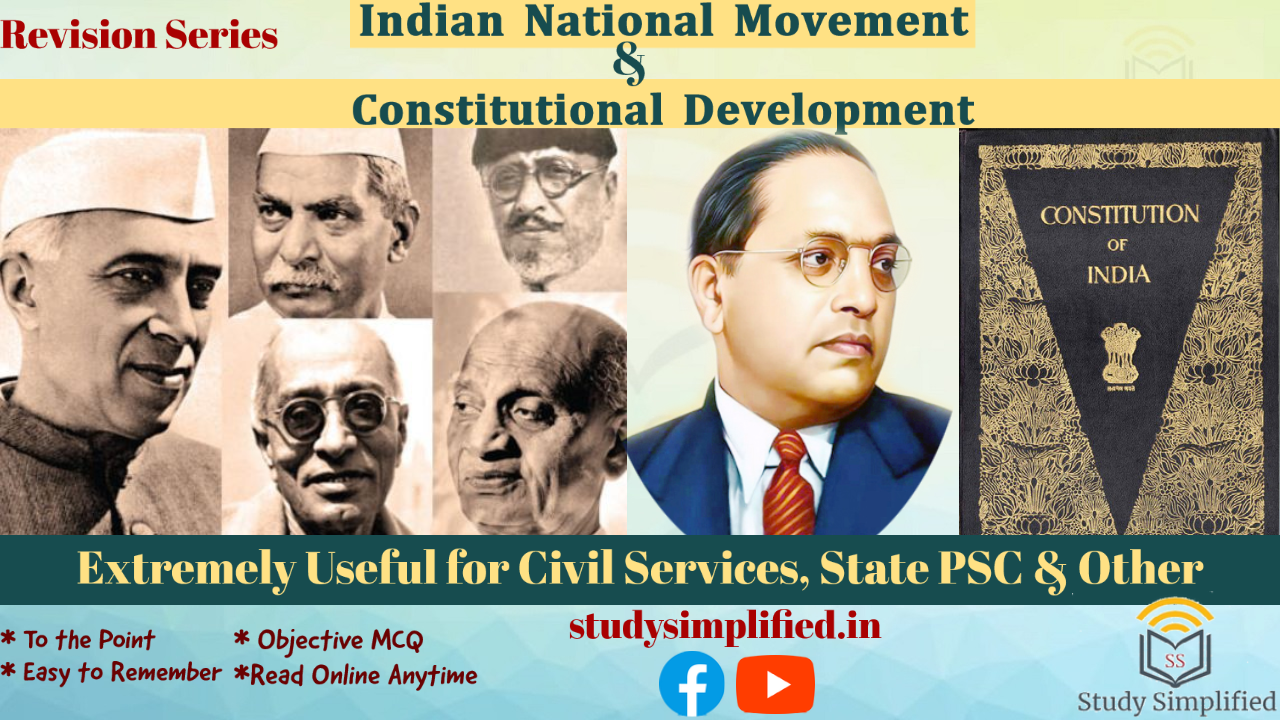𝐈𝐧𝐝𝐢𝐚𝐧 𝐍𝐚𝐭𝐢𝐨𝐧𝐚𝐥 𝐌𝐨𝐯𝐞𝐦𝐞𝐧𝐭 & 𝐂𝐨𝐧𝐬𝐭𝐢𝐭𝐮𝐭𝐢𝐨𝐧𝐚𝐥 𝐃𝐞𝐯𝐞𝐥𝐨𝐩𝐦𝐞𝐧𝐭 𝐄𝐱𝐜𝐥𝐮𝐬𝐢𝐯𝐞 𝐑𝐄𝐕𝐈𝐒𝐈𝐎𝐍 𝐒𝐄𝐑𝐈𝐄𝐒

Why read Indian National Movement and Constitutional Development ?
Reading Indian National Movement and Constitutional Development is pivotal for understanding the intricate tapestry of India’s journey towards independence and the subsequent shaping of its constitutional framework. Here’s why:
- Historical Context: The Indian National Movement was a watershed moment in Indian history, marking the struggle against colonial rule and the assertion of national identity. Understanding this movement provides crucial insights into the socio-political dynamics of colonial India, including the impact of British policies, the rise of nationalism, and the role of various leaders and organizations.
- Strategies and Tactics: Studying the Indian National Movement offers a rich repository of strategies and tactics employed by freedom fighters. From non-violent resistance led by Mahatma Gandhi to revolutionary movements championed by figures like Bhagat Singh, the movement showcased a diversity of approaches aimed at achieving a common goal – freedom from British rule.
- Constitutional Evolution: The constitutional development of India is deeply intertwined with its struggle for independence. The demand for self-governance and the quest for a representative system laid the groundwork for constitutional reforms. The Montagu-Chelmsford Reforms, Simon Commission, and Government of India Acts were significant milestones in this journey, culminating in the framing of the Indian Constitution.
- Constitutional Principles: The Indian Constitution, adopted in 1950, embodies the aspirations and values of the Indian National Movement. It enshrines principles such as democracy, secularism, social justice, and fundamental rights, which were integral to the nationalist discourse. Understanding the historical context helps in appreciating the rationale behind these constitutional provisions.
- Legacy and Impact: The Indian National Movement continues to shape India’s identity and governance. The ideals of freedom struggle, such as unity in diversity and inclusive development, resonate in contemporary India. Moreover, the constitutional framework established through this movement forms the bedrock of Indian democracy, providing a roadmap for governance and accountability.
- Global Significance: The Indian National Movement inspired similar struggles for independence across the world. Leaders like Gandhi became symbols of resistance against colonialism, influencing movements in Africa, Asia, and beyond. By studying this movement, one gains insights into the global dynamics of decolonization and nation-building.
- Relevance in Contemporary Times: The principles and struggles of the Indian National Movement remain relevant in addressing contemporary challenges. Issues of social justice, inequality, and communal harmony continue to echo the themes of the freedom struggle. Moreover, debates surrounding constitutional amendments and democratic governance often refer back to the foundational principles established during this period.
In essence, studying the Indian National Movement and Constitutional Development is not merely an academic exercise but a journey into the soul of India’s nationhood. It offers a profound understanding of its past, illuminates its present, and guides its future trajectory towards a more inclusive and democratic society.
This Book Contains Quick REVISION of very Important Articles in Indian National Movement and Constitutional Development. This is a very handy Book useful for any Competitive Exam.
Salient Feature of the Book
- To the Point focus on Important Events
- Short and Crisp
- Easy to remember and Revise
- Objective MCQ included
- Maps included whenever necessary
- Read online from any Device from anywhere
Contents
- Revolts prior to 1857
- The Revolt of 1857
- Socio-Religious and Cultural Reform Movements
- Foundation of the INC
- Moderate Phase (1885 – 1905)
- Rise of Militant Nationalism
- The Non Co-Operation Movement
- The Civil Disobedience Movement
- Peasant Movement
- Trade Union Movement
- Tribal Movement
- Communalism in India
- Quit India Movement
- The Indian National Army to Independence
- The Indian Independence Act, 1947
- Constitutional Developments
- Reorganization of British Raj after 1857
- Famous National Personalities
- Questions
An Appeal
Dear Readers/Students Community,
Read Online Only available currently to support us.
You can Read this Book by only accessing this Page.
Kindly support our hard work to motivate Hard Working needy students like you.
So Please VISIT to OUR WEBPAGE REGULARLY
Enjoy the Reading for free and prepare well for your Exams.
Enjoy the Reading.
𝓦𝓪𝓲𝓽 𝓯𝓸𝓻 𝓶𝓸𝓻𝓮 𝓲𝓷𝓽𝓮𝓻𝓮𝓼𝓽𝓲𝓷𝓰 𝓐𝓻𝓽𝓲𝓬𝓵𝓮𝓼.
Read Indian National Movement and Constitutional Development Book Here